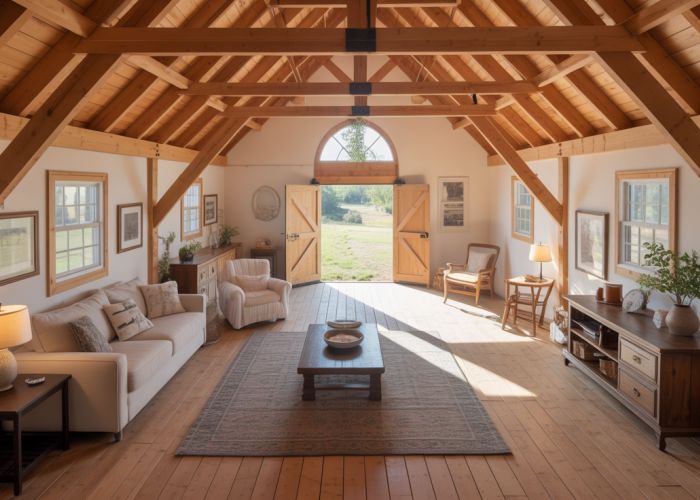Pole barn construction offers a unique framework for adaptable spaces; pole barn lofts particularly exemplify this versatility. These elevated areas, commonly built within the larger structure, provide solutions for increased storage or living space. Builders often incorporate engineered trusses to support loft construction; these components are designed for specific load-bearing requirements. Material costs for pole barn lofts can vary significantly depending on choices made for finishing and functionality. Homeowners seeking to maximize their property’s utility increasingly explore the benefits of integrating pole barn lofts into their existing or new construction.

Crafting the Ultimate "Pole Barn Lofts" Article: A Structural Guide
To create an engaging and helpful article about "Pole Barn Lofts: Transform Your Space! Designs & Costs," focusing on the keyword "pole barn lofts," we need a clear and organized structure. This will guide readers through understanding what pole barn lofts are, how they can be designed, and what costs to expect.
Understanding Pole Barn Lofts
This section should act as an introduction to the entire topic.
What Exactly Are Pole Barn Lofts?
- Definition: Begin by clearly defining what a pole barn loft is. Emphasize that it’s an elevated space within a pole barn structure, often used for storage, living, or working. Briefly touch upon the advantages of using post-frame construction to support lofted areas.
- Typical Uses: List common uses for pole barn lofts:
- Storage (seasonal items, equipment, etc.)
- Living space (apartments, guest rooms, home offices)
- Workshops or studios
- Recreational areas (game rooms, home theaters)
- Why Choose a Pole Barn Loft? Highlight the benefits that attract people to them:
- Cost-effectiveness compared to adding entirely new structures.
- Maximize usable space within an existing building footprint.
- Flexibility in design and customization.
- Increased property value.
Exploring Pole Barn Loft Design Ideas
This section is crucial for inspiring readers and showcasing the versatility of pole barn lofts.
Loft Design Styles & Considerations
- Categorizing Loft Designs: Present different loft styles based on functionality or aesthetics. For example:
- Storage Lofts: Focus on maximizing storage capacity, accessibility, and organization.
- Living Lofts: Emphasize comfort, privacy, and amenities (kitchenette, bathroom).
- Multi-Purpose Lofts: Designed to adapt to various uses over time.
- Essential Design Considerations: Detail the key factors influencing loft design.
- Load Capacity: Explain the importance of calculating the weight the loft needs to support.
- Headroom: Emphasize the need for adequate vertical space for comfortable movement.
- Accessibility: Discuss different access options (stairs, ladders, ramps) and their implications.
- Natural Light & Ventilation: Highlight the importance of windows and ventilation for comfort.
- Building Codes & Permits: Underscore the necessity of complying with local regulations.
- Visual Inspiration: Include images and examples of different pole barn loft designs. Consider creating a gallery showcasing various styles, materials, and layouts.
Key Design Elements
- Flooring Options: Describe popular flooring choices for pole barn lofts, including pros and cons for each:
- Plywood
- OSB (Oriented Strand Board)
- Hardwood
- Concrete
- Framing Materials: Briefly discuss different framing materials and their properties:
- Lumber (dimensional lumber)
- Steel
Estimating the Cost of Pole Barn Lofts
This is where readers look for concrete information, so providing a clear breakdown is crucial.
Factors Affecting Loft Construction Costs
-
Loft Size & Complexity: Explain how the square footage and the complexity of the design impact the overall cost.
-
Materials Used: Detail the cost differences between various materials for framing, flooring, walls, and finishes. Consider providing a simple table.
Material Average Cost per Sq. Ft. Notes Lumber (Framing) $X – $Y Depends on grade and local market. Plywood (Flooring) $A – $B Different thicknesses affect price. Drywall (Walls) $C – $D Includes installation and finishing costs. -
Labor Costs: Explain that labor costs vary depending on the region and the complexity of the job.
-
Permitting Fees: Mention that obtaining the necessary permits can add to the overall expense.
-
DIY vs. Professional Installation: Compare the cost savings of DIY with the advantages of professional installation (quality, safety, adherence to building codes).
Sample Cost Estimates
- Provide hypothetical cost ranges for different types of pole barn lofts. For example:
- Basic Storage Loft: $X to $Y per square foot.
- Finished Living Loft: $A to $B per square foot.
-
Illustrative Scenario: Present a sample scenario with specific dimensions and materials to give readers a more concrete idea of the potential cost.
Example: A 20′ x 30′ storage loft, using plywood flooring and basic lumber framing, with DIY installation, might cost between $Z and $W.
So, ready to start dreaming about all the possibilities pole barn lofts could bring to your property? Get those creative gears turning!